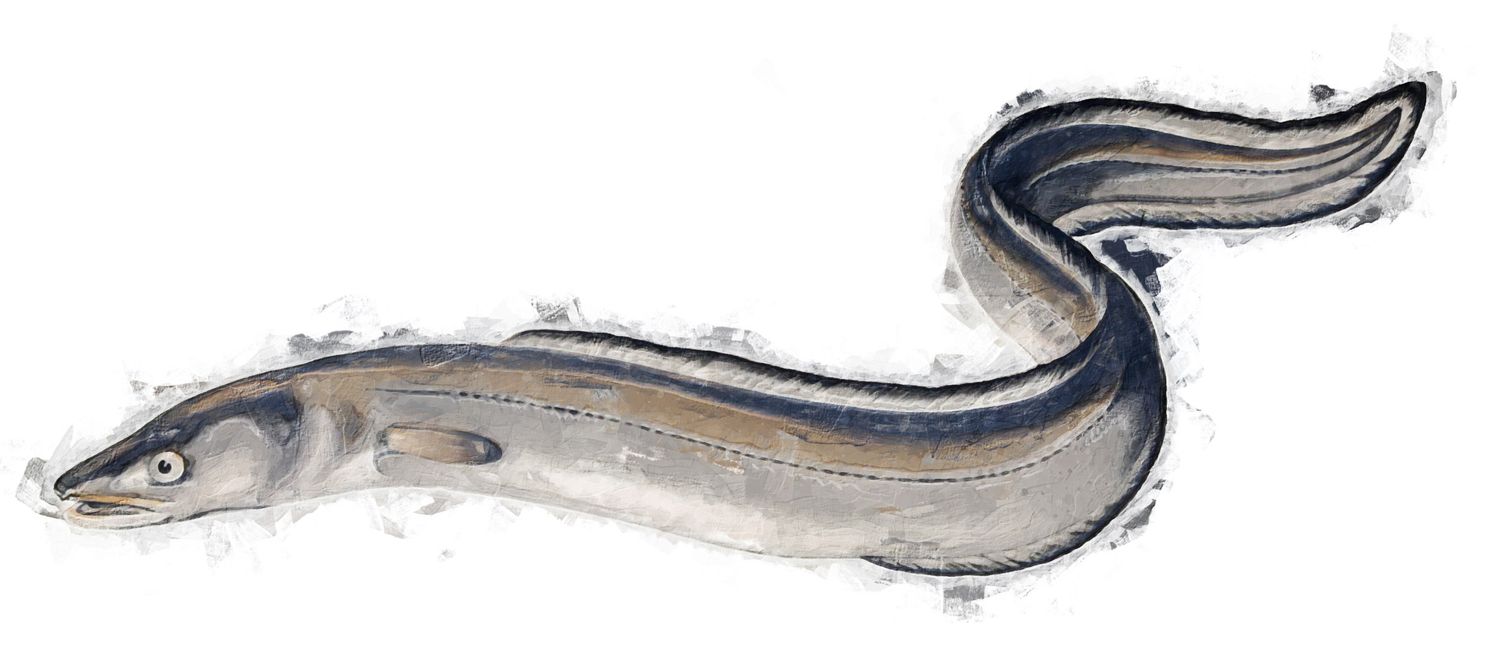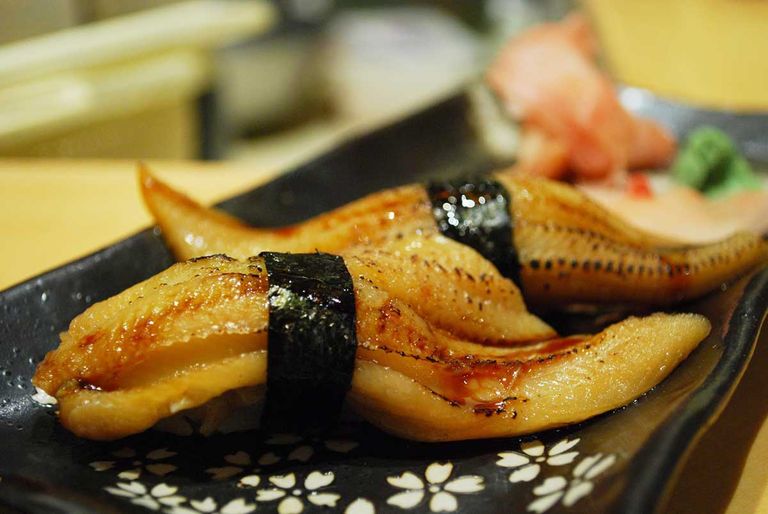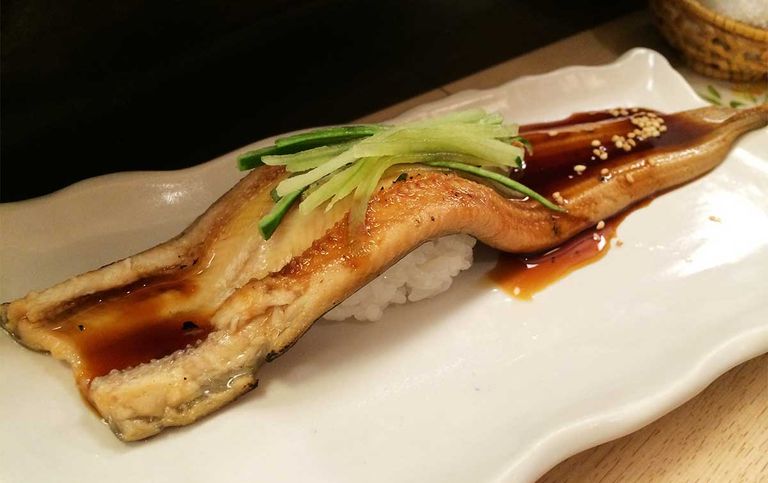Anago Sushi
A Comprehensive Overview of Marine Eel in Japanese Sushi Cuisine
アナゴすし 、 穴子寿司 
What is Anago?
In the field of ichthyology, the Japanese term anago 穴子 generally refers to fish from the Congridae family, also known as conger eels. This family can be further subdivided into various subgroups: chin anago チンアナゴ, honmedama anago ホンメダマアナゴ and kuro anago クロアナゴ.
In a culinary context, particularly in the preparation of sushi, the genus conger, also known colloquially as anago, is of outstanding importance. This is mainly due to the appreciated texture and taste of its meat, which is often used in traditional dishes. Although species from other genera of the Congridae family are occasionally used for sushi, anago remains the preferred choice. A particularly prized species within this group is C. Myriaster, which is known as maanago マアナゴ in Japanese. This name can be translated as “real conger eel”, which underlines its esteem and its central role in Japanese cuisine. Maanago is characterized by its particularly tender meat and delicate aroma, which makes it a sought-after ingredient in high-quality sushi preparation.
Anago for Sushi or Sashimi
Anago is counted among the traditional representatives of the cooked sushi ingredients (nimono dane). Therefore, prepared anago sushi is also often called ni anago 煮穴子. The broth that results from cooking the anago meat is boiled down, refined, and then used to glaze the meat. This tasty salty sweet sauce is called nitsume 煮詰め and is an essential part of the taste experience when eating anago nigiri sushi.
The meat is so soft that it almost falls apart and offers a full-bodied sweet taste. The texture is extremely pleasant and melts on the tongue. Anago harmonizes very well with vinegared sushi rice and is often preferred over freshwater eel (unagi) for the preparation of sushi. In contrast to unagi, anago is less greasy, sweeter and has a finer taste.
Nitsume 煮詰め
Nitsume or short tsume (つめ), is the golden brown colored sauce with which anago is glazed. It plays a central role in the process of preparation anago sushi and is decisive for the quality of the taste. Tsume is a thick sauce that is created by boiling down the broth from anago. The addition of the ingredients can vary and depends on the preferences of the cook. Most basic recipes consist of the anago broth left over from the preparation, some bones, and heads, alcohol, sugar, and soy sauce. The skillful balancing of the ingredients gives the tsume a sweet and spicy taste. Traditional or sophisticated restaurants often make them according to a personal, usually secret, recipe and prepare them from scratch each time. In inexpensive restaurants, industrially produced tsume is mainly used. When serving anago nigiri sushi, the sauce should not be poured or drizzled over the meat, but applied as a thin glaze with a brush.
Best Season for Anago
The best season for anago is during summer. It is particularly tasty from July to August, when the fat content is at its highest and the taste is at its fullest. The rest of the year they are also very tasty, so that they can be enjoyed all year round.
Ecologoy of Anago
Anago are predominantly nocturnal and start to search for prey at dusk. As carnivores, they feed mainly on small fish, crustaceans, mollusks, and small cephalopods. During the day, they hide in the sandy mud or in the crevices on the seabed. The species that live on the sandy, muddy bottom form groups and stretch their heads or even half of their bodies out of their burrows into the sea. The body shape of anago is elongated and cylindrical, the absence of scales is typical for the species. Adult specimens vary in length from about 30 cm to over 1 m, depending on the species. The distribution area ranges from tropical to temperate seas worldwide.
The family of the Congridae can be divided into three subfamilies:
| Family | Japanese |
| Bathymyrinae | honmedama anago ホンメダマアナゴ |
| Congrinae | kuro anago クロアナゴ |
| Heterocongrinae | chin anago チンアナゴ |
Toxic blood
The blood of the anago contains dinogunellin (ichthyotoxin), which is poisonous to humans and has a blood-dissolving effect. Even small doses can cause severe gastroenterological problems, nervous system disorders and pain. During preparation, care must be taken that the poison does not get into contact with mucous membranes, eyes or open wounds. The toxin is inactivated by sufficient heating above 70 °C or 158° F.[1][2]
The toxin extracted from eel blood serum was used by Charles Richet in his Nobel Prize winning research, in which he discovered anaphylaxis.[3]
Economy of Anago
Comparatively, few conger eels species are actively fished, but mostly end up as bycatch in the nets of industrial fisheries. A sustainable method is to catch them using special traps. These traps consist of tubes or hoses in which a potential prey is prepared. The traps are constructed in such a way that they taper off from the inlet. If a conger eel tries to get to the prey, it cannot leave the tube after passing the narrowing and can be collected by the fisherman.
Japan consumes more than 70 percent of the world's eel catch, with about half coming from China, South Korea and Taiwan.
Season Calendar for Anago
The calendar shown does not provide information on fishing times, but marks the periods in which anago is considered particularly tasty.
Warnings related to Anago
Video about Anago Sushi
External video embedded from: youTube.com. Credit Kirikosushi. Anago, Sea eel. Kiriko sushi Sawtelle Los Angeles. Ken Namba.
Species of Anago
The following species are regarded as authentic anago. Either historically, according to the area of distribution or according to the common practice in today's gastronomy: The term anago encompasses a variety of species that are grouped together under these names. Due to the extensive diversity of these species, it is not always possible to list all specific taxa in this list completely.
0
In the following, those species are listed that can be considered as substitutes for authentic species with regard to anago. This can be based either on their genetic relationship or on their similarity in taste and appearance. The selection is subjective and is not strictly based on Japanese conventions, but also takes into account the practices in the respective areas where the Japanese dishes are prepared. This flexible approach allows for adaptation to local availability and preferences while preserving the core flavor and texture traditionally associated with anago.
Sources and Further Reading
- [1]Jiri Davidek. Natural Toxic Compounds of Foods. CRC Press, Taylor & Francis Group, Boca Raton. 2018
- [2]Jan Velisek, Richard Koplik, Karel Cejpek. The Chemistry of Food. John Wiley & Sons, Chichester. 2020
- [3]Dujardin-Beaumetz, E.P. Hurd (transl.). Diseases of the Stomach and Intestines: A Manual of Clinical Therapeutics for the Student and Practitioner. William Wood & Company, New York. 1886
- [4]Fish and Fishery Products Hazards and Controls Guidance. U.S. Department of Health and Human Services Food and Drug Administration Center for Food Safety and Applied Nutrition. 2020
- Celeste Heiter. The Sushi Book. Things Asian Press. 2007
- Christine T. Tjandraningsih. Indonesia eel hot item for smugglers. japantimes.co.jp, The Japan Times, News2u Holdings Inc., Tokyo, 2013-07-29. Source retrieved 12/24/2020
- Kazuko Masui, Chihiro Masui. Sushi Secrets. Hachette Illustrated, London. 2004
- Marc Luber, Brett Cohen. Stuff Every Sushi Lover Should Know. Quirk Books, Philadelphia. 2019
- 『「㐂寿司」の門外不出のツメづくりに密着 (A Close Look at the Secret Process of Making Tsume-dzukuri at "Kizushi")』. dancyu.jp, President Inc. (株式会社 プレジデント社)、 2019-09-09. Source retrieved 12/24/2020
- 美登世 土田、潤 髙橋、秀美 佐藤. 『すしのサイエンス:おいしさを作り出す理論と技術が見える (The Science of Sushi: Seeing the Theory and Technology Behind the Deliciousness of Sushi)』. Sibundo Shinkosha (誠文堂新光社), Tokyo (東京). 2020
- IUCN Red List of Threatened Species. Version 2023-1
Image Credits
- SushiPedia. Eel Nigiri Sushi with Nitsume Sauce. All rights reserved ©
- SushiPedia. Anago Sushi. All rights reserved ©
- Alpha. Anago - Shira Nui AUD5.50 each. flickr.com. Some rights reserved: CC BY-SA 2.0. Changes applied: brightness, contrast, noise, white balance

